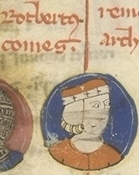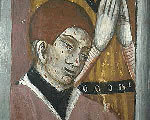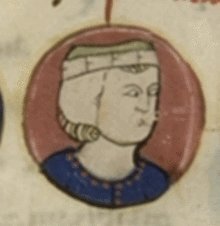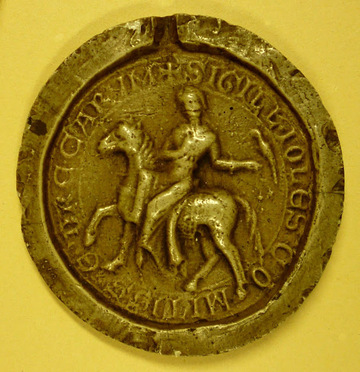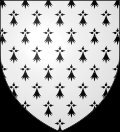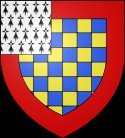maximum test » Pierre "Mauclerc" de Dreux I (± 1186-1250)
Persönliche Daten Pierre "Mauclerc" de Dreux I
- Spitzname ist Mauclerc.
- Er wurde geboren rund 1186 in Braine, Aisne, PicardyFrance.
- Er wurde getauft in Brittany-Duke Pierre.
- Fetauft (im Alter von 8 Jahren oder später) von der Priestertumsvollmacht der HLT-Kirche am 4. August 1993.
- Titel: Duc
- Berufe:
- Duc, Comte, Trouvère.
- Duc, de Bretagne, Comte, de Dreux, de Braine, de Penthièvre, de Tréguier, de Richmond, Poète, Croisé.
- Er ist verstorben am 26. Mai 1250 in At sea en route to France.
- Er wurde beerdigt im Jahr 1250 in Premonstratensian Abbey Church of Saint-Yved, Braine, Aisne, Picardy, France.
- Ein Kind von Robert De Dreux und Yolande de Coucy
- Diese Information wurde zuletzt aktualisiert am 9. Februar 2020.
Familie von Pierre "Mauclerc" de Dreux I
Er ist verheiratet mit Alix de Thouars.
Sie haben geheiratet Februar 1212 in Brittany, France.
Kind(er):
Notizen bei Pierre "Mauclerc" de Dreux I
nicknamed Mauclerc?
styled Mauclerc, 2nd son of Robert II, COUNT OF DREUX AND BRAINE, by his 2nd wife, Yolande, 1st daughter of Ralph DE COUCI, LORD OF COUCI, was born circa 1187-90. He was knighted by the King of France 17 May 1209. By his marriage with Alice of Brittany he became DUKE OF BRITTANY in February 1212/3. In 1213 he served in Flanders under the King of France, and helped the French to defend Touraine against King John, whom he defeated in 1214 before Nantes. On 12 August 1215 John offered him the honor of Richmond, if he would come to his aid in England; but Piers took the other side and helped Prince Louis. However, on 16 January 1218/9 Henry III ordered seisin of the lands of the Earldom of Richmond to be given to Piers, whereupon he became EARL OF RICHMOND. In 1219 he joined in the Crusade against the Albigenses. On 3 March 1222/3 he defeated Amaury de Craon at Châteaubriant. In November 1224 he was deprived for a few months of the honor of Richmond. He returned to the Crusade against the Albigenses in 1226. On 19 October 1226 Henry III undertook to marry his daughter Yolande, but the project broke down; in March 1226/7 Piers concluded the Treaty of Vendôme with Louis IX, and in April 1227 Henry ordered his lands to be seized. In October 1229 he did homage to Henry III, and he was restored to the Earldom of Richmond. In June 1230 the French barons declared his forfeiture, and on 23 September he concIuded a new treaty with Henry III. With the Earl of Chester he negotiated a 3 years' truce between the rival Kings on 4 July 1231; but after this expired he was compelled to submit to Louis, and in January 1234/5 his English lands were confiscated. He was included in the 5 years' Anglo-French truce of 3 February 1235/6. In November 1237 he surrendered the Duchy to his son, after which he styled himself Piers de Braine. In 1239 he led a Crusade to Palestine, and in 1249 he went on Crusade with St. Louis. He was wounded in the face at the battle of Mansourah, and surrendered with the King at Faraskur, 6 April 1250. On being released he sailed from Damietta, 7 May 1250, but died at sea. During his rule in Brittany he was constantly engaged in quarrels with the bishops, and more than once he was excommunicated. He was a bencfactor to many monastic foundations and, to the Templars in Brittany.
He married, 1stly, in February 1212/3, Alice, elder daughter and coheir of Guy DE THOUARS, sometime DUKE OF BRITTANY, by Constance, DUCHESS OF BRITTANY. She died 21 October 1221, and was buried in the convent of the Cordeliers at Nantes. He married, 2ndly, about January 1234/5, Margaret, LADY OF MONTAIGU and LA GARNACHE, widow of Hugh DE THOUARS, VICOMTE OF THOUARS, next brother of Guy abovenamed, who died s.p., 1230 (before May), and daughter and heir of Maurice DE MONTAIGU, LORD OF MONTAIGU, by Chaboce (parentage unknown). She died about the end of 1241. Charter, as an act of last will, dated 27 November 1241. Piers married, 3rdly, Joan, LADY OF CRIEL, younger daughter of Ralph D'EXOUDUN, COUNT OF EU, by Alice, COUNTESS OF EU, daughter and heir of Henry, COUNT 0F EU. Piers died probably circa 28 May 1250, at sea, and was buried in the abbey of St. Yved-de-Braine, near Laon. Will made circa August 1248. His widow died 3 October 1252, in the Hospital of Brackley, Northants, and was buried in the abbey of Foucarmont. [Complete Peerage X:800-5, (transcribed by Dave Utzinger)]
Duc de Bretagne
{geni:about_me} ==PIERRE I "Mauclerc" Duke of Brittany==
* PIERRE de Dreux, son of ROBERT [II] Comte de Dreux et de Braine & his second wife Yolande de Coucy ([1187]-at sea off Damietta end-May 1250, bur Braine, église abbatiale de Saint-Ived). The Chronicle of Alberic de Trois-Fontaines names (in order) "Henricum archiepiscopum Remensem et tres comites, Robertum de Brana, Petrum de Britannia, Iohannem Masticonesem et eorum sorores numero septem" as children of "comiti de Brana Roberto" and his wife Yolande[343]. He swore allegiance at Paris 27 Jan 1213 to Philippe II "Auguste" King of France as PIERRE I "Mauclerc" Duke of Brittany. Comte de Penthièvre by annexation 1214. He was created Earl of Richmond by Henry III King of England 16 Jan 1219 (confiscated Nov 1224, restored Oct 1229, confiscated again Jan 1235). “Johannes comes Matisconensis” names “frater meus P. comes Britannie” in a charter dated Aug 1234[344]. He surrendered the duchy of Brittany to his son in 1237, after which he is sometimes referred to as PIERRE de Braine. William of Tyre (Continuator) names "Pierre de Drues cuens de Bretaigne" among those who took part in the crusade from France which landed at Acre in 1239[345]. He accompanied King Louis IX on crusade in 1249 and was captured at Faraskur 6 Apr 1250, after being wounded at the battle of Mansurah. He died at sea on his return to western Europe.
==Wives==
* Married: firstly ([Mar 1213/Oct 1214]) ALIX de Thouars Dss of Brittany, daughter of GUY de Thouars & his second wife Constance Dss of Brittany ([1200]-21 Oct 1221, bur 24 Nov 1225 Villeneuve-les-Nantes, Abbaye de Notre-Dame). The Genealogia Comitum Richemundiæ names "Adelicia" as the daughter of "Constantia filia Conani" and her third husband "Guidoni de Thoarcio", stating that she married "domno Petro Mauclerc"[346]. The Chronicle of Alberic de Trois-Fontaines names "unam filiam Mabiliam" as the child of "Constantiam comitis Conani filia" and her [third] husband "Guido frater vicecomitem de Tuart"[347]. The Chronique de Guillaume de Nangis records that daughter of Guy de Thouars and Constance de Bretagne married "Pierre Mauclerc, fils de Robert comte de Dreux"[348]. A Chronicon Comitum Pictaviæ et Aquitaniæ Ducum names "Alipsam et Catherinam" as the two daughters of "Wido…comes de Thoarcio" and "Constantiam Gaufridi Ducis Britanniæ relictam", stating that Alix married "Petro Comiti Drocarum"[349]. The Chronicon Britannicum records the death "XII Kal Nov" in 1221 of "Aalis Ducissa Britanniæ"[350]. Betrothed (before 21 Jul 1229) to [MARIE] de Lusignan, daughter of HUGUES I King of Cyprus & his wife Alix of Jerusalem Ctss of Jaffa ([before 1215]-[1251/53]). A Papal prohibition on the marriage between "comes Britannie" and "filiam reginam Cypri", by reason of 4o consanguinity, is dated at Pérouse 21 Jul 1229[351]. It is not known which daughter was betrothed to the Duke of Brittany, but it is a reasonable assumption that it was Marie who was the older of the queen’s two daughters.
* Married: secondly ([1230]) NICOLE, daughter of --- (-Feb 1232, bur Villeneuve-les-Nantes, Abbaye de Notre-Dame). Her marriage is confirmed by an epitaph at Villeneuve which records the burial of "Nicolle, la mère monsour Olivier de Machecou"[352], read together with the charter dated 10 Mar 1258 under which "Jehan duc de Bretaigne conte de Richemont" confirmed an agreement between "Morice de Belle Ville, par raison de Jehanne sa femme, dame de la Roche sur Yon et de Luçon" and "Olivier nostre frère" concerning "la terre de Machecoul et de Saint Philbert"[353]. No indication has been found of Nicole’s parentage.
* Married thirdly (before Jan 1236) as her second husband, MARGUERITE de Montaigu Dame de Montaigu et de La Garnache [en Poitou], widow of HUGUES de Thouars Seigneur de Montaigu, daughter of --- ([1188/90]-after 27 Nov 1241). "Petrus dux Britanie, comes Richemundie, dominus Gasnapie et Margarita uxor eius" confirmed donations to the abbey Blanche de Noirmoutier by charter dated 1236[354]. The difficulties connected with identifying Marguerite’s correct parentage are discussed in the section showing the seigneurs de Montaigu in the document POITOU -WESTERN. "Margarita uxor…Petri de Brana, Montis Acuti et Gasnapie domina" confirmed the same donations to the abbey Blanche de Noirmoutier by charter dated 1239[355]. "Margarita domina Gasnapie, Montis Acuti et Machecolii" confirmed the donation of a marsh made to Buzay by "le curé de Bouin" by charter dated Jul 1239[356]. "Margarita Montis Acuti et Guasnapiædomina et hæres" donated property to the abbey of Geneston, with the consent of "viro nostro Petro de Brana", by charter dated 27 Nov 1241[357]. A charter dated 27 Nov 1241, contained in a vidimus dated 6 May 1644, records that “Margarita Montis Acuti et Ganachiæ domina et heres” donated property to the hospital at Montaigu, with the consent of “viro nostro Petro de Brana”[358].
==Duke Pierre I & his first wife ALIX de Thouars Dss of Brittany had three children==
* 1. '''JEAN de Bretagne''' ([1217/18]-Château de l'Isle, Férel, Morbihan 8 Oct 1286, bur Prières, église abbatiale de Notre Dame). The Chronicon Ruyensis Cœnobii records the birth in 1217 of "Johannes filius Petri Comitis et Aelidis Comitissæ Britanniæ"[359]. The Chronicon Britannicum records the birth in 1218 of "Johannes, filius Petri Ducis Britanniæ"[360]. He succeeded on the abdication of his father in 1237 as JEAN I "le Roux" Duke of Brittany.
* 2. '''YOLANDE de Bretagne''' (in Brittany end 1218-château de Bouteville 10 Oct 1272, bur Villeneuve-les-Nantes, église abbatiale de Notre Dame). A letter of King Henry III dated 19 Oct 1226 confirms his betrothal to "Jolentam filiam Petri ducis Brittanniæ et comitis Richemundiæ"[361]. The Chronicon Turonense records the betrothal of "Rex Franciæ Joannem fratrem suum, puerum octennem" and "filiæ Petri Comitis Britanniæ", and the grant of the county of Anjou to him[362]. The marriage contract between “P. dux Britannie, comes Richemondie…Yolendi filie mee” and “Ludovicus, rex Francorum…Johannem fratrem suum” is dated 27 Mar [1226/27][363]. The Annals of Dunstable recordthe betrothal of “filiam comitis Britanniæ” and “rex Franciæ…fratri suo minori”, who received the county of Anjou, in 1227[364]. Her betrothal to Thibaut IV Comte de Champagne is confirmed by a letter from King Louis IX to ComteThibaut, dated 1229, which states that the king had “entendu que vous avez convenancé et promis à prendre à femme la fille du Comte Pierre de Bretaigne” and forbade him from proceeding, adding “la raison pourquoi vous savez bien”(without providing any further explanation)[365]. The 1229 date (cited by Lobineau) is presumably incorrect, assuming that the date of death of Comte Thibaut´s second wife is correctly reported as 11 Jul 1231 as shown above. This suggested redating is confirmed by a letter from Pope Gregory IX to the archbishop of Bourges dated 24 Apr 1232 stating that “Campaniæ et Britanniæ comites” intended to arrange a marriage alliance prohibited by the degrees of consanguinity and forbidding the arrangement[366]. Dame de la Fère-en-Tardenois, de Chailly et de Longjumeau. Ctss de Penthièvre 1236, as her dowry. The Chronicon Britannicum records in 1236 that "Penthevria excepto Jugonio" wasgranted to “Hugoni filio comitis de Marchia” with “filia Petri comitis totius Britanniæ”[367]. Ctss de Porhoët, by grant of her brother. "Hugo Lebrun, filius comitis Marchie primogenitus, et dominus Lambalie et Hyolandis uxor sua" noted the end of the excommunication of "Guidonem de Argenteio dominum de Plancoit" in a charter dated 1246[368]. "Hugo Brunus comes Engolisme et domina Hiolendis uxor eius heres et domina Penthevrie" confirmed the donation to Lamballe made by “domini P. quondam ducis Britannie genitoris predicte Hiolendis uxoris nostre...domine Ælidis ducisse Britannie et comitisse Richem. genitricis predicte Hiolendis” by charter dated Jul 1247[369]. Regent of La Marche and Angoulême 1250-1256. Betrothed (before 19 Oct 1226) to HENRY III King of England, son of JOHN King of England & his second wife Isabelle Ctss d'Angoulême (Winchester Castle 1 Oct 1207-Palace of Westminster 16 Nov 1272, bur Westminster Abbey). Betrothed (Mar 1227) to JEAN de France Comte d'Anjou et du Maine, son of LOUIS VIII King of France & his wife Infanta doña Blanca de Castilla (Sep 1219-1232, bur Notre-Dame de Poissy). [370]Betrothed ([1231], terminated) to THIBAUT IV Comte de Champagne, son of THIBAUT III Comte de Champagne & his wife Infanta doña Blanca de Navarra (Pamplona 3 May 1201-Pamplona 8 Jul 1253, bur Pamplona). m (Jan 1236) HUGUES [XII] de Lusignan, son of HUGUES [XI] de Lusignan Comte de la Marche et d'Angoulême & his wife Isabelle Ctss d'Angoulême ([1221]-Damietta Apr 1250, bur Abbaye de la Couronne, Charente). He succeeded his father in 1250 as Seigneur de Lusignan, Comte de la Marche et d'Angoulême.
* 3. ''' ARTHUR de Bretagne''' ([1220]-shortly after 1223). Lobineau records the birth in 1220 of “un second fils...Artur” but cites no primary source on which he bases this date[371]. The Chronicon Turonense records the betrothal in 1223 of "Arturo puero, filio Comitis Britanniæ" and "Amorricus de Credone, senescallus Andegaviæ, filiam unicam"[372]. Betrothed to JEANNE de Craon, daughter of AMAURY [I] Seigneur de Craon & his wife Jeanne des Roches. The Chronicon Turonense records the betrothal in 1223 of "Arturo puero, filio Comitis Britanniæ" and "Amorricus de Credone, senescallus Andegaviæ, filiam unicam"[373].
==Duke Pierre & his second wife NICOLE had one child==
* 4. '''OLIVIER [I] de Braine dit de Machecoul''' [1231/32]-1279, bur Villeneuve-lez-Nantes). His parentage is confirmed by the charter dated 10 Mar 1258 under which "Jehan duc de Bretaigne conte de Richemont" confirmed an agreement between "Morice de Belle Ville, par raison de Jehanne sa femme, dame de la Roche sur Yon et de Luçon" and "Olivier nostre frère" concerning "la terre de Machecoul et de Saint Philbert"[374]. The identity of his motheris confirmed by an epitaph at Villeneuve which records the burial of "Nicolle, la mère monsour Olivier de Machecou"[375]. [Seigneur de Machecoul.]
'''Source''' - Projects MedLands Dukes of BRITTANY http://fmg.ac/Projects/MedLands/BRITTANY.htm#PierreIdied1250MAlixDssBretagneB
==Peter I, Duke of Brittany, From Wikipedia, the free encyclopedia==
Pierre Mauclerc (c. 1190– 6 July 1250), also known as Peter of Dreux or Pierre de Dreux, was duke of Brittany (in right of his wife) from 1213 to 1221, then regent of the duchy (for his minor son) from 1221 to 1237.
He was the second son of Robert II, Count of Dreux. The latter was in turn the son of Robert I of Dreux, a younger brother of Louis VII of France. Pierre was thus descended from the Capetian dynasty, and was a second cousin of Louis VIII of France.
Despite being of royal descent, as the younger son of a cadet branch Pierre's early prospects were that of a minor noble, with a few scattered fiefs in the Île-de-France and Champagne.
However, in 1212 King Philip II of France needed to find a weak and faithful ruler for Brittany. The duchy lay athwart the sea lanes between England and the English territories in Gascony. Furthermore it bordered on Anjou and Normandy, which the English had lost a decade or twelve before and were eager to recover. It was being ruled with less than a strong hand by Guy of Thouars, as regent for his young daughter Alix. Also worrisome was that Alix's older half-sister Eleanor, Fair Maid of Brittany was in an English prison.
And so King Philip broke off the betrothal of Alix and the Breton prince Henry of Penthièvre, and turned to his French cousin Pierre, then in his early twenties. Pierre married Alix, and on January 27, 1213, paid homage to the king for Brittany.
There is some ambiguity regarding whether Pierre should be considered duke or count of Brittany. King and Pope (and their courts) always addressed him as "count", but Pierre in his own charters used "duke".
In 1214 King John of England had assembled a formidable coalition against the French. He landed in Poitou while King Otto of Duitsland prepared to invade from the north. John chased off some French forces in the north of Poitou, andthen moved to the southern edge of Brittany, opposite Nantes. Pierre drove him off after a brief skirmish but did nothing to hinder John's subsequent movement up the Loire valley where he took a few Breton fortresses and then besieged La Roche-aux-Moines. John's Poitivan vassals, however, refused to fight against a French force led by Prince Louis (later Louis VIII of France). Meanwhile, Otto's army was crushed at Bouvines, and the entire invasion foundered.
It is not clear why John attempted to capture Nantes/Naoned, even less why he would do so the hardest way, via the very well-defended bridge across the Loire. Nor is it clear why Pierre declined to harass his forces from the rear as John marched east. A likely explanation is that the two had come to some sort of agreement whereby John would leave Brittany alone for the moment, and in return the Bretons would not hinder him elsewhere.
John had a prize he could dangle in front of Pierre: the Earldom of Richmond. This great English honour (land) had traditionally been held by the dukes of Brittany, and in fact a constant theme in Pierre's political affairs was the desire to hold and retain the English revenues from Richmond.
Pierre did not yield to King John's offers to accept the earldom and take up the King's side in his conflicts with the English barons, probably because he deemed the King's prospects too uncertain. Moreover, Prince Louis was againfighting against the English. But when Louis was defeated, Pierre was sent as one of the negotiators for a peace treaty. After the negotiations were completed (in 1218), William Marshal, the regent for the young Henry III of England, recognized Pierre as Earl of Richmond. The center of the earldom's properties in Yorkshire was in the hands of the Earl of Chester, whom the regent could not afford to antagonize, but Pierre did receive the properties of the earldom outside of Yorkshire, which in fact generated the bulk of the earldom's income.
While the negotiations were slowly proceeding, Pierre turned his attention to his next goal. The authority of the dukes of Brittany had traditionally been weak, in comparison to the great peers of northern France. For example, theduke could not limit the building of castles by his counts. Nor did he have the right to guardianship of minor heirs of his vassals. Pierre aimed to re-establish his relationship with his vassals (or subjects) more along the lines of what he knew from the Capetian royal court.
To that end Peter simply declared new rules by fiat, and then faced the inevitable turmoil that resulted from the reaction of his barons. There followed a series of small civil wars and political maneuverings, but by 1223, the barons had all acquiesced to the changes or been dispossessed.
The six Breton bishops were the other threat to the ducal power, for they had substantial landholdings (including control of all or part of the few cities in Brittany), and were recalcitrant in the face of Pierre's attempts to raise revenues by increasing taxes or simply taking possession of episcopal holdings. For this he was excommunicated for a time in 1219–1221. Pierre submitted in the end, but this was not to be the last of his conflict with the bishops.
Pierre's wife Duchess Alix died on October 21, 1221, leaving behind four young children. She was then only 21, and little is known about her beyond the basic genealogical facts.
Her death meant that Pierre was no longer duke, although he continued to rule the Duchy with undiminished authority, as regent for his son John, then a boy of four or so.
Alix's death changed Pierre's goals in two ways. First, he aimed to acquire some additional territory, not part of the Duchy, to augment his retirement after his son came of age. Second, there was a strong tradition in France thata minor heir should, when coming of age, have his property in the state it was in when he inherited it. Thus Pierre could not now take some risks without fear of harming the prospects of his son.
==Links==
* http://en.wikipedia.org/wiki/Peter_I,_Duke_of_Brittany
* and in French: http://fr.wikipedia.org/wiki/Pierre_Ier_de_Bretagne
* http://homepages.rootsweb.ancestry.com/~cousin/html/p395.htm#i7808
* http://www.the-orb.net/textbooks/crusade/seventhcru.html
* http://thepeerage.com/p10680.htm#i106796
==Sources==
* Painter, Sidney. The Scourge of the Clergy: Peter of Dreux, Duke of Brittany. Oxford University Press: London, 1937
* Projects MedLands Dukes of BRITTANY - http://fmg.ac/Projects/MedLands/BRITTANY.htm#PierreIdied1250MAlixDssBretagneB
PED FROM ELIZABETH ANN KELSO - BORN 27 JUN 1926
KNOWN AS "MAUCLERC"; KNIGHT BY KING OF FRANCE 5/17/1209, AND BY MARRIAGE TO
ALICE DE THOUARS BECAME DUKE OF BRITTAMY IN 1212/3; TOOK PART INTERMITTENTLY IN
THE ALBIGENSIAN CRUSADE (1219-26); LED A CRUSADE TO PALESTINE; IN 1249 WENT ON
A CRUSADE WITH KING LOUIS (WOUNDED AT THE BATTLE OF MANSOURAH AND SURRENDERED
WITH lOUIS AT FARASKUR, 4/6/1250 - RELEASED 5/6/1250, BUT DIED OF HIS WOUNDS
WHILE AT SEA); GAVE CHARTES CATHEDRAL IT GREAT ROSE WINDOW (WITH 6 ADJOINING
WINDOWS IN THE SOUTH TRANSEPT)
baillistre de Bretagne (1213-1237), duc consort de Bretagne (1213-1237), comte de Braine, comte de PenthiΦvre og de TrΘguier (1222) (Pierre de Dreux).
Zeitbalken Pierre "Mauclerc" de Dreux I
Diese Funktionalität ist Browsern mit aktivierten Javascript vorbehalten.
Klicken Sie auf den Namen für weitere Informationen.
Verwendete Symbole:  Großeltern
Großeltern
 Eltern
Eltern
 Geschwister
Geschwister
 Kinder
Kinder
 Großeltern
Großeltern
 Eltern
Eltern
 Geschwister
Geschwister
 Kinder
Kinder
Vorfahren (und Nachkommen) von Pierre de Dreux
Pierre de Dreux 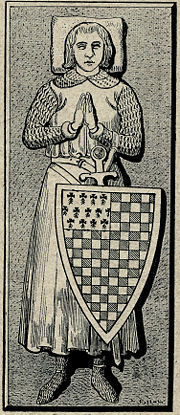 | ||||||||||||||||||||||||||||||||||
1212 | ||||||||||||||||||||||||||||||||||
Alix de Thouars | ||||||||||||||||||||||||||||||||||
Die angezeigten Daten haben keine Quellen.
Anknüpfungspunkte in anderen Publikationen
Diese Person kommt auch in der Publikation vor:Historische Ereignisse
Taufdatum 4. August 1993
- Die Temperatur am 4. August 1993 lag zwischen 13,9 °C und 21,5 °C und war durchschnittlich 17,0 °C. Es gab -0,1 mm Niederschlag. Es gab 5,7 Stunden Sonnenschein (37%). Es war Halb- bis Schwerbewölkt. Die durchschnittliche Windgeschwindigkeit war 2 Bft (Schwacher Wind) und kam überwiegend aus Süd-Westen. Quelle: KNMI
- Koningin Beatrix (Huis van Oranje-Nassau) war von 30. April 1980 bis 30. April 2013 Fürst der Niederlande (auch Koninkrijk der Nederlanden genannt)
- Von Dienstag, 7 November, 1989 bis Montag, 22 August, 1994 regierte in den Niederlanden das Kabinett Lubbers III mit Drs. R.F.M. Lubbers (CDA) als ersten Minister.
- Im Jahr 1993: Quelle: Wikipedia
- Die Niederlande hatte ungefähr 15,2 Millionen Einwohner.
- 21. August » Der Funkkontakt zur NASA-Raumsonde Mars Observer bricht endgültig ab.
- 27. September » Beim Massaker von Sochumi werden über 7.000 georgische Zivilisten in Abchasien ermordet.
- 5. Oktober » Die UNAMIR-Mission der Vereinten Nationen wird nach Ruanda gesandt.
- 26. Oktober » Wegen des Mordes an zwei Polizisten im Jahr 1931 wird der frühere DDR-Minister für Staatssicherheit Erich Mielke zu sechs Jahren Freiheitsstrafe verurteilt.
- 11. Dezember » In Chile gewinnt der Christdemokrat Eduardo Frei Ruiz-Tagle die Präsidentschaftswahlen gegen den parteilosen Kandidaten Arturo Alessandri.
- 30. Dezember » Israel und der Heilige Stuhl beschließen die Aufnahme diplomatischer Beziehungen.
Sterbedatum 26. Mai 1250
- Graaf Willem II (Hollands Huis) war von 1234 bis 1256 Fürst der Niederlande (auch Graafschap Holland genannt)
Gleicher Geburts-/Todestag
- 1241 » Roger Bernard II., Graf von Foix
- 1339 » Anna, litauische Prinzessin und Königin von Polen
- 1362 » Ludwig von Tarent, Fürst von Tarent, König von Neapel und Graf von Provence
- 1375 » Konrad II. von Kirchberg-Wallhausen, Bischof von Meißen
- 1390 » Ferry Cassinel, Erzbischof von Reims
- 1401 » Andreas Franchi, italienischer Dominikaner, Bischof von Lucca, Orvieto und Pistoia
Über den Familiennamen De Dreux
- Zeigen Sie die Informationen an, über die Genealogie Online verfügt über den Nachnamen De Dreux.
- Überprüfen Sie die Informationen, die Open Archives hat über De Dreux.
- Überprüfen Sie im Register Wie (onder)zoekt wie?, wer den Familiennamen De Dreux (unter)sucht.
Die maximum test-Veröffentlichung wurde von Ard van Bergen erstellt.
Geben Sie beim Kopieren von Daten aus diesem Stammbaum bitte die Herkunft an:
Ard van Bergen, "maximum test", Datenbank, Genealogie Online (https://www.genealogieonline.nl/maximum-test/I6000000000796842681.php : abgerufen 28. Dezember 2025), "Pierre "Mauclerc" de Dreux I (± 1186-1250)".
Ard van Bergen, "maximum test", Datenbank, Genealogie Online (https://www.genealogieonline.nl/maximum-test/I6000000000796842681.php : abgerufen 28. Dezember 2025), "Pierre "Mauclerc" de Dreux I (± 1186-1250)".
